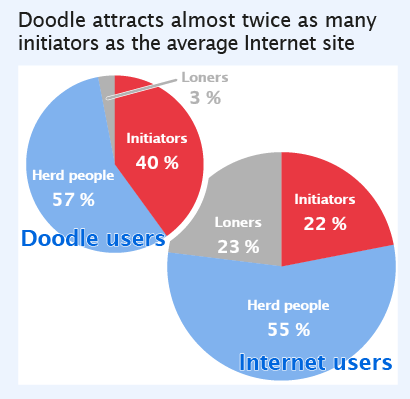 A recent study by online meetings scheduling service Doodle caught my eye this week. They found that there are three distinct personality roles when it comes to people and their meetings: initiators, herders, and loners. The first type is pretty easy to understand: they organize about half of the meetings without any further help from the rest of us. Herders are those who may organize a few meetings now and then but for the most part are content to just let someone else take hold of their schedules. And the loners just sit by themselves, and don’t attend too many meetings anyway.
A recent study by online meetings scheduling service Doodle caught my eye this week. They found that there are three distinct personality roles when it comes to people and their meetings: initiators, herders, and loners. The first type is pretty easy to understand: they organize about half of the meetings without any further help from the rest of us. Herders are those who may organize a few meetings now and then but for the most part are content to just let someone else take hold of their schedules. And the loners just sit by themselves, and don’t attend too many meetings anyway.
The breakdown of the three roles is also interesting in terms of what tools they use (to no surprise, the initiators use online services such as Doodle to set up their meetings, so they can be more effective).
If you have ever tried to setup a meeting with two or more people via email, you probably need to take a look at Doodle or SetMeeting.com or one of the other services that I mention in this blog entry that I did earlier this year for Mozy. They work in a similar fashion presenting in your Web browser free and busy times that you can choose from to find a common period that you can all gather around the conference call to chat.
Now, how to start meetings on time? That doesn’t take any software, just an iron fist. I once had a boss who loved to have everyone gather in his office, where there was a large conference table. He would stay behind his desk, doing email or talking on the phone, while we all waited until he was ready to honor us with his attention and start the meeting. I am sure you have had similar horror tales.
My colleague Steve Epner recalls a consulting gig he had at one organization where the meetings got started later and later. As word got around that meetings weren’t going to start on time, more participants took their sweet time to get there and things just spiraled out of control.
They fixed the problem by synchronizing their conference room clocks and making sure that the meeting organizer would arrive five minutes early, and start the meeting exactly on time, regardless of who was present. Even after tardy attendees arrived, they kept going, rather than backtrack. In a few months the meetings ran better. Once the word got around that the start time was absolute, everyone started to show up promptly.
Pingback: The end of meetings could be upon us | Web Informant